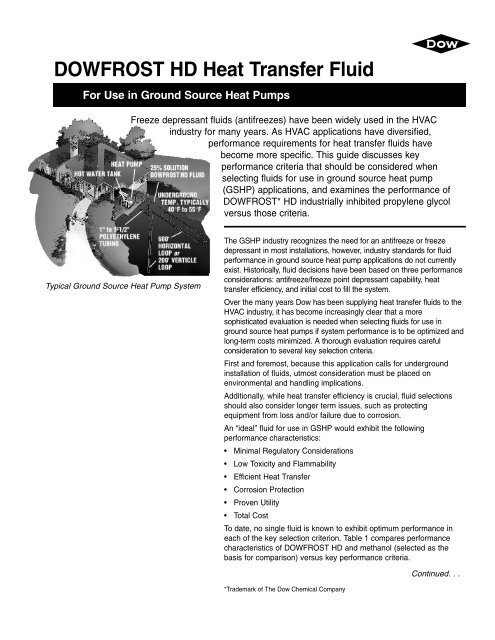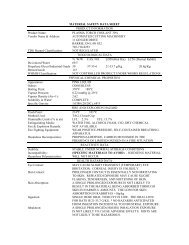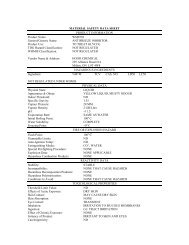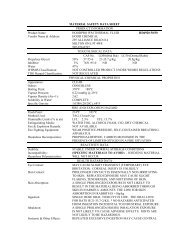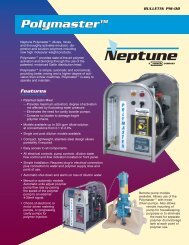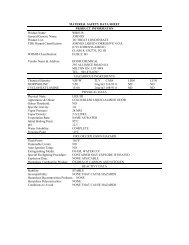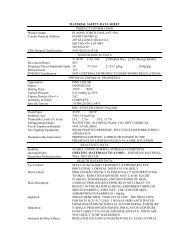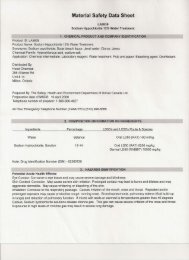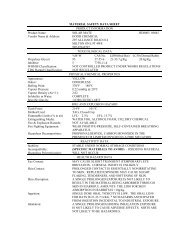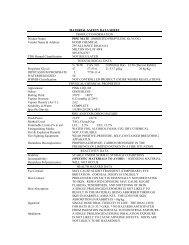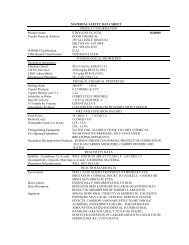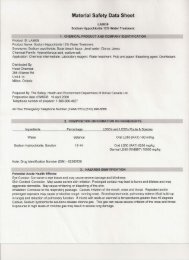DOWFROST HD Heat Transfer Fluid For Use In - Hood Chemical
DOWFROST HD Heat Transfer Fluid For Use In - Hood Chemical
DOWFROST HD Heat Transfer Fluid For Use In - Hood Chemical
- No tags were found...
Create successful ePaper yourself
Turn your PDF publications into a flip-book with our unique Google optimized e-Paper software.
<strong>DOWFROST</strong> <strong>HD</strong> <strong>Heat</strong> <strong>Transfer</strong> <strong>Fluid</strong><strong>For</strong> <strong>Use</strong> in Ground Source <strong>Heat</strong> PumpsFreeze depressant fluids (antifreezes) have been widely used in the HVACindustry for many years. As HVAC applications have diversified,performance requirements for heat transfer fluids havebecome more specific. This guide discusses keyperformance criteria that should be considered whenselecting fluids for use in ground source heat pump(GSHP) applications, and examines the performance of<strong>DOWFROST</strong>* <strong>HD</strong> industrially inhibited propylene glycolversus those criteria.Typical Ground Source <strong>Heat</strong> Pump SystemThe GSHP industry recognizes the need for an antifreeze or freezedepressant in most installations, however, industry standards for fluidperformance in ground source heat pump applications do not currentlyexist. Historically, fluid decisions have been based on three performanceconsiderations: antifreeze/freeze point depressant capability, heattransfer efficiency, and initial cost to fill the system.Over the many years Dow has been supplying heat transfer fluids to theHVAC industry, it has become increasingly clear that a moresophisticated evaluation is needed when selecting fluids for use inground source heat pumps if system performance is to be optimized andlong-term costs minimized. A thorough evaluation requires carefulconsideration to several key selection criteria.First and foremost, because this application calls for undergroundinstallation of fluids, utmost consideration must be placed onenvironmental and handling implications.Additionally, while heat transfer efficiency is crucial, fluid selectionsshould also consider longer term issues, such as protectingequipment from loss and/or failure due to corrosion.An “ideal” fluid for use in GSHP would exhibit the followingperformance characteristics:• Minimal Regulatory Considerations• Low Toxicity and Flammability• Efficient <strong>Heat</strong> <strong>Transfer</strong>• Corrosion Protection• Proven Utility• Total CostTo date, no single fluid is known to exhibit optimum performance ineach of the key selection criterion. Table 1 compares performancecharacteristics of <strong>DOWFROST</strong> <strong>HD</strong> and methanol (selected as thebasis for comparison) versus key performance criteria.Continued. . .*Trademark of The Dow <strong>Chemical</strong> Company
Continued from Page 1A Word About Performance Criterion: What You Should Consider When Selecting a <strong>Fluid</strong>Regulatory ConsiderationsThis criterion is high priority because potential leaks could lead to contamination (of both the soil and watersupplies). The fluid must be low in toxicity to wildlife, readily biodegradable, and not listed or characterized ashazardous material subject to RCRA regulation (e.g., the flash point must be greater than 140ºF).<strong>DOWFROST</strong> <strong>HD</strong> fluid satisfies all these requirements. However, methanol is highly toxic, with a flash point of54ºF and subject to RCRA regulation even when diluted to 20% by volume concentration. This low flash pointcauses methanol to be characterized as a hazardous waste upon disposal.Toxicity and Flammability<strong>In</strong> the interest of fire safety, the fluid selected should not have a low flash point (94% propylene glycol) is an FDAapproved food additive. By comparison, methanol is characterized as relatively high in both acute oral andinhalation toxicity. And, due to its low flash point, extra safety precautions should be taken during installationand system operations to guard against fire and protect both the health and safety of those involved.Efficient <strong>Heat</strong> <strong>Transfer</strong>At the concentration required for typical (25ºF) freeze protection, the fluid is not likely to be the limiting factor inheat transfer efficiency for the overall system. Though the heat transfer coefficient of methanol is somewhatbetter than that of <strong>DOWFROST</strong> <strong>HD</strong>, in the great majority of GSHP applications, the limiting factor is the heattransfer of the earth/piping or the refrigerant in the evaporator. Therefore, slight differences in fluid heat transferefficiency do not impact the overall system’s heat transfer. It is possible (even likely) that changing frommethanol to <strong>DOWFROST</strong> <strong>HD</strong> fluid will have no measurable impact on overall system heat transfer efficiency,even though the individual fluid coefficients differ.Corrosion Protection<strong>In</strong> order to ensure the long-term success of the system and its equipment, the fluid must pass ASTM D-1384corrosion evaluation, and should provide 20-year corrosion protection for heat pump systems without anyrequired maintenance during that period.<strong>DOWFROST</strong> <strong>HD</strong> provides corrosion protection well within the recommended guidelines for typical metals, and canprovide 20+ years of worry-free protection. However, when methanol is used, the fluid is often installed without, orwith improper, corrosion inhibitors. This could lead to serious corrosion problems and equipment failure.Proven UtilityThe product selected should have demonstrated utility for all above criteria for similar HVAC freeze protectionsituations. The <strong>DOWFROST</strong> <strong>HD</strong> formulation has demonstrated its effectiveness for corrosion protection, heattransfer, human safety, and environmental protection in typical HVAC applications over decades of use in theindustry.Total CostCost evaluation should consider the long-term system maintenance and replacement costs, total pumpingcosts, and initial installation costs. Comparisons which simply look at initial purchase price of the fluid mayskew the long-term system economics by ignoring other factors such as maintenance and replacement costs offluid and equipment.
Table 2: Residential Total Monthly Cost Comparison(Modeled After a Typical 3 Ton Application)Methanol, 2 ft/sec.<strong>In</strong> Ground <strong>In</strong> <strong>Heat</strong> Pump<strong>DOWFROST</strong> <strong>HD</strong>, 2 ft/sec.<strong>In</strong> Ground <strong>In</strong> <strong>Heat</strong> Pump<strong>Fluid</strong> <strong>Heat</strong> <strong>Transfer</strong> Coefficient 204 695 120 465System <strong>Heat</strong> <strong>Transfer</strong> Coefficient 5.5 107 5.4 95Pressure Drop/100 ft 2 1.1 21.5 1.38 26.5Pump Horsepower(Per 2000 ft in ground/10 ft in heat pump) .100 .0096 .124 .011Electric Pump Cost per Kilowatt $ .08 $ .08 $ .08 $ .08Total Monthly Electric Cost $2.39 $2.95Typical Physical Properties of <strong>DOWFROST</strong> <strong>HD</strong>Composition (% by weight)Glycol 94.0<strong>In</strong>hibitors & Water 6.0ColorBright yellowSpecific Gravity (at 60/60ºF) 1.053 - 1.063pH of Solution (50% glycol) 9.5 - 10.5Reserve Alkylinity (min.)15.0 mlIf you would like additional product information or specific engineering or operating assistance, call Dowtoll free: 1-800-447-4369
<strong>For</strong> further information, call...<strong>In</strong> North America: 1-800-447-4369<strong>In</strong> Latin America: 1-517-832-1556<strong>In</strong> Europe: (+31) 20-691-6418<strong>In</strong> Asia/Pacific: (+886) 2715-3388http://www.dow.com/heattransNOTICE: No freedom from any patent owned by Seller or others is to be inferred. Because use conditions and applicable laws may differ from one location toanother and may change with time, Customer is responsible for determining whether products and the information in this document are appropriate forCustomer’s use and for ensuring that Customer’s workplace and disposal practices are in compliance with applicable laws and other governmental enactments.Seller assumes no obligation or liability for the information in this document. NO WARRANTIES ARE GIVEN; ALL IMPLIED WARRANTIES OFMERCHANTABILITY OR FITNESS FOR A PARTICULAR PURPOSE ARE EXPRESSLY EXCLUDED.Published June 2000.Printed in U.S.A.*Trademark of The Dow <strong>Chemical</strong> Company<strong>For</strong>m No. 180-01391-600QRP


